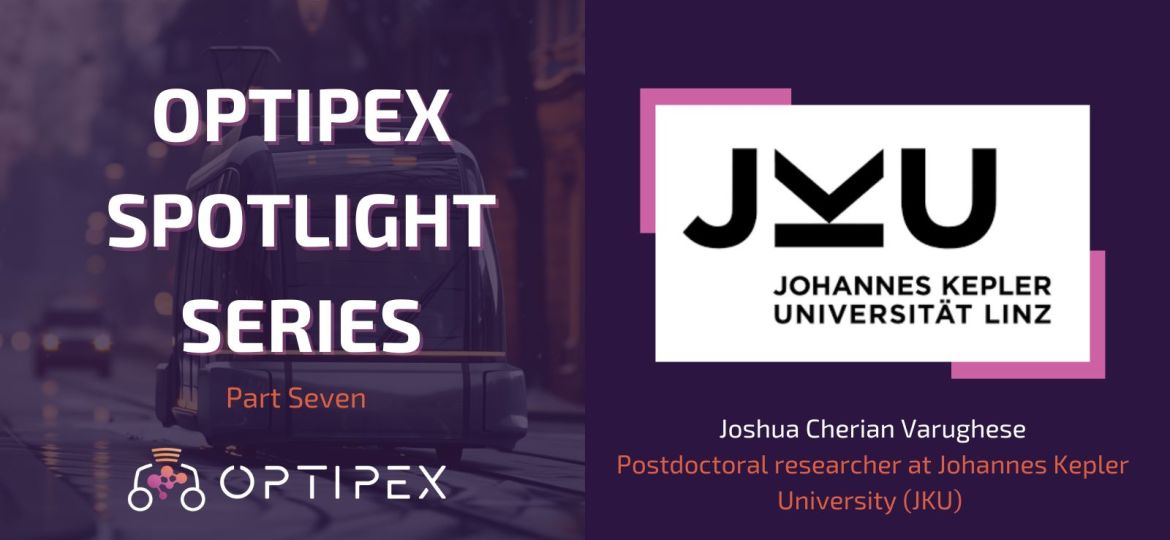
Welcome to the second edition of OptiPEx’s Spotlight Series! In this edition, we sit down with Joshua Cherian Varughese postdoctoral researcher at Johannes Kepler University (JKU) in Linz, Austria, to explore his organization’s role in the OptiPEx project.
Thank you for speaking with us today. Could you start by introducing yourself?
Hi there. My name is Dr. Joshua Cherian Varughese. I am a postdoctoral researcher at the Department Intelligent Transport Systems, working under Head Univ. Prof. Dr. Cristina Olaverri-Monreal at the Johannes Kepler University (JKU) in Linz, Austria.
What does your organisation do?
The Department Intelligent Transport Systems (ITS) at the JKU is a well-established unit with in-depth knowledge and practical experience in the core areas of intelligent technologies in vehicular environments (ICT, data analysis and smart mobility) and mobile sensors that support automated, cooperative and connected transport. The department is involved in thematic networks around transportation with many years of experience in the academic training and in the research of transport-relevant topics. It aims at providing transport solutions for a low environmental impact using sensor and communication technologies for data exchange between vehicles, infrastructure, and people. The focus lies particularly on human factors and interaction with intelligent vehicles and automated connected transportation. Additionally, we also study machine learning based driving behaviour simulation, develop sustainable transportation models, create driving simulation platforms and analyse both travel behaviour and driving performance.
Can you tell us about your general experience with public transport in your city?
In the city of Linz, Austria, the public transport system operates efficiently, offering a network of trams, buses, and shuttles that ensure commuters can travel in and out of the city with ease and punctuality. The vehicles are designed to be comfortable and easily accessible, enhancing the overall travel experience. While the system is extensive, there are opportunities for expansion, particularly in the southeastern industrial area, where enhanced connectivity could further benefit the community. During peak times, such as school dismissals, university hours, or city events, the high demand can occasionally lead to full trams, presenting a chance to further improve seating availability, especially for elderly passengers, pregnant women, and people with disabilities.
One clear direction of development is the transition of traffic from tires to rails in general. Especially the share of trams has grown considerably.
Based on this, why is a project like OptiPEx necessary?
Projects like OptiPEx open the stage to vulnerable people groups to share their experience through surveys, focus groups and interviews. We expect to collect valuable feedback which can then be translated into technologies and implemented in cooperation with the transport operator. For example, during peaking of demand for public transport, information about occupancy could be collected and provided to those waiting at bus/tram stations so that they could better plan their journey. The same information could also be provided to the public transport operators.
What role does your organisation play in the OptiPEx project?
Our organization plays a key role in the project, leveraging its expertise in essential areas. We will collect stakeholder feedback while adhering to GDPR, ensuring privacy. Our focus is on developing cutting-edge technology to assess and optimize passenger comfort and safety in real time, addressing GDPR compliance and AI Act risks. Collaborating with public transport operators like the Linz A.G. and manufacturers like the Skoda Group, we will incorporate their expertise in ethical technology development within European regulations.
We will contribute to the project by implementing pedestrian-to-vehicle communication, centred on predicting potential collisions between pedestrians and trams, with future support for autonomous trams.
Additionally, we aim to enhance the onboard passenger experience by identifying less crowded areas and available seats.
What will a successful contribution to the project look like for your organization?
A successful contribution to the project will involve implementing and testing an occupancy monitoring system and a collision-alert and avoidance system in trams, in collaboration with public transport operators in Linz. This will include the deployment of AI/ML algorithms for collision prediction using camera, compass, and GPS data, along with a robust communication infrastructure and sensors for vehicle location and orientation. A robot prototype will assess communication effectiveness, while computer vision-based algorithms will estimate occupancy levels and automate air conditioning adjustments in trams.
What do you see as the biggest challenge for the project?
One of the biggest challenges in the project is to identify and address actionable concerns with regards to passenger experience in public transport and to implement them in conformance with various regulations on ethics, technology and public space use.
What does your organization hope to achieve between now and month 18 of the project?
Between now and M18 of the project, we hope to have tested the first version of the occupancy monitoring system and the first version of the collision-alert system.
Can you describe OptiPEx in three words?
Improving passenger experience.